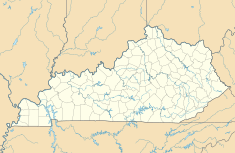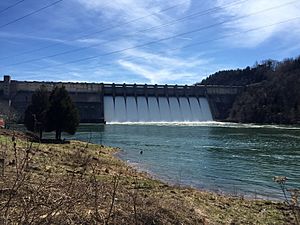Wolf Creek Dam facts for kids
Quick facts for kids Wolf Creek Dam |
|
|---|---|
 |
|
|
Location of Wolf Creek Dam in Kentucky
|
|
| Location | Russell County, Kentucky |
| Coordinates | 36°52′06″N 85°08′51″W / 36.8683°N 85.1475°W |
| Construction began | 1941 |
| Opening date | 1951 |
| Operator(s) | U.S. Army Corps of Engineers |
| Dam and spillways | |
| Impounds | Cumberland River |
| Height | 258 ft (79 m) |
| Length | 5,736 ft (1,748 m) |
| Dam volume | 11,396,500 cu yd (8,713,200 m3) |
| Reservoir | |
| Creates | Lake Cumberland |
| Total capacity | 6,089,000 acre⋅ft (7,511,000 dam3) |
| Catchment area | 5,789 sq mi (14,990 km2) |
| Surface area | 50,250 acres (20,340 ha) |
| Power station | |
| Turbines | 6x 45.0 MW |
| Installed capacity | 270 MW |
The Wolf Creek Dam is a large dam built on the Cumberland River in Russell County, Kentucky, United States. This dam is very important because it does four main things. First, it makes hydroelectricity, which is power from water. Second, it helps control and stop floods. Third, it lets out water so boats can travel on the lower Cumberland River all year. Finally, it created Lake Cumberland, which is a super popular place for fun activities and tourism.
The dam has had some problems with water leaking through its base. Because of this, fixing Wolf Creek Dam is a top priority for the U.S. Army Corps of Engineers. You can even drive across the top of the dam on U.S. Route 127.
Contents
Building the Dam: A Look at Construction
Building the Wolf Creek Dam was approved by special laws in 1938 and 1946. It was part of a big plan to manage the Cumberland River. Construction started in 1941. However, because of World War II and other reasons, the dam wasn't finished until 1951. The last power generators were put in place in 1952.
Lake Cumberland is one of four main dams that help control floods in the Cumberland River area. The other dams are J. Percy Priest Dam, Dale Hollow Dam, and Center Hill Dam.
Some small towns nearby, like Creelsboro and Burnside, were affected by the dam's construction. But the dam has saved hundreds of millions of dollars by preventing flood damage over the years.
How the Dam is Built: Key Features
The Wolf Creek Dam is very long, measuring 5,736 ft (1,748 m) (about 1.1 miles). It is also 258 ft (79 m) (about 25 stories) high. The dam is made from a mix of earth and concrete.
The concrete part of the dam is about 1,794.62 ft (547.00 m) long. This section crosses the old river channel. It has a spillway with ten large gates called tainter gates. There are also six smaller gates called sluice gates that let water out from lower levels.
Inside the power section, there are pipes called penstocks. These pipes carry water to six powerful turbines, each making 45 megawatts of electricity. The earthen part of the dam stretches for about 3,937.008 ft (1,200.000 m) across the valley. It is made of tightly packed clay.
Water Leaks: Understanding Seepage Problems
In 1968, engineers found signs of seepage (water leaking) in the earthen parts and base of Wolf Creek Dam. They saw holes appearing on the ground below the dam. Muddy water was also seen flowing out from the dam's drainage channel.
These leaks happened because of the special type of rock under the dam, called karst. Karst is a kind of limestone that can dissolve when water flows through it. Over time, this creates channels or tunnels in the rock. These channels allow water to leak through the dam's base, which can cause more erosion.
Imagine the ground under the dam is like a giant sponge with hidden tunnels. When rain or snow melts, the water picks up carbon dioxide from the air. This makes a weak acid that slowly eats away at the limestone rock. This creates empty spaces or "voids" in the rock. When a big lake like Lake Cumberland sits on top, the water pressure can push out the natural clay that fills these cracks.
Wolf Creek Dam is mostly an earth-filled dam. This means a large part of it is made of packed earth. The earth part of the dam sits directly on the ground. Even though the top part of the dam is waterproof, the hidden tunnels in the karst rock far below can let water leak through the dam's base. This is what caused the seepage problem.
Engineers first tried a quick fix by injecting grout (a special type of cement) into the leaks from 1968 to 1970. This helped save the dam. Then, a longer-term solution began in 1975. They built a concrete cut-off wall that went deep into the earth and rock foundation. This wall was finished in 1979.
Recent Efforts to Stop Leaks
Even with the fixes, monitoring showed that the leaks were still happening and getting worse. People became worried because if Wolf Creek Dam failed, it could cause a lot of damage. It seemed that water had found new ways to leak around or even through the old cut-off wall.
Since March 2005, when more leaks were found, the water level in Lake Cumberland has been kept lower than usual. This reduces the pressure on the dam and its foundation.
In early 2007, the U.S. Army Corps of Engineers said the dam was at "high risk" for failure. They also said the same about Center Hill Dam in Tennessee. A new plan was proposed to fix the leaks. This plan included more grouting and a new, stronger concrete barrier wall using modern technology.
To lower the risk, the Corps planned to drop Lake Cumberland's water level even more. However, this would affect the water supply for many people and upset marina owners. So, the lake level was lowered by 40 ft (12 m) below normal, instead of the planned 83 ft (25 m). This lower level was kept for a long time and checked often. In October 2007, warning sirens were put in place in towns downstream from the dam.
Work on the new concrete barrier wall inside the dam started in April 2009. This new wall was completed in 2013. After the wall was finished, the water levels in Lake Cumberland were returned to normal in 2014.
Images for kids







